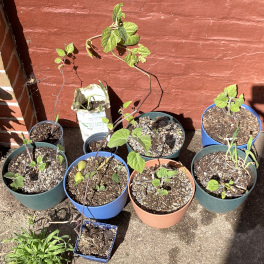Ayacucho Giant Cape Gooseberry
A couple of years ago now I got some Cape Gooseberries (Physalis peruviana) from the grocery store, just to try them. They were really good, so I saved some seeds from those berries and also ordered seeds of a couple of varieties (and other Physalis species, mostly Ground Cherries (P. pruinosa)) to try growing them. Among them were this variety of giant cape gooseberries from Ayacucho, Peru.
A varietal cape gooseberry, recently found in the Ayacucho region of Peru by plant explorer J. Simcox. It bears plump fruits, larger in size than standard cape gooseberries, with excellent, sweet flavor.
~ Ayacucho Giant Cape Gooseberry :: Trade Winds Fruit
These grew large, but only one (the largest one) made flowers, and none of those fruited, but then they didn't die. They just kept growing until the living room was full of them. I wanted to preserve them and bring them up to the land, if they like it there they should do nicely. Eventually I ran out of room and cut them back, but they all regrew and some of the cuttings rooted. Finally in the pressure to reduce "stock" (to make it easier to move) I decided to forego these plants and just grow new ones from seed up at the land. So I put them outside, thinking that they were tropical and so the cold would kill them and I could reclaim the pots (US$3.50 @ with water resevoirs on the bottom. I'm not losing those!) However, the plants were all like, "Dude, we're from Peru." and just kept alive and even grew. They are actually pretty hard to kill (see the one growing out of the four inch pot? The root ball is in the air.)
Anyway, we have about ten of these now.
They provide fruit (obviously) but also cuttings. These are slow to root, but I haven't tried rooting hormones yet.

